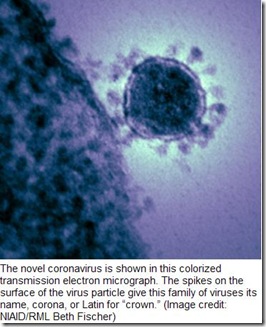
Photo Credit NIAID
UPDATED: Confirmed at 7:20am EDT by Gregory Hartl, spokesperson for WHO.

# 7214
It’s being widely reported this morning (see Reuters, AFP, Al Jazeera stories) that 5 Saudis have died in recent days from the novel coronavirus (hCoV-EMC aka NCoV), and that two more remain in Intensive Care.
Caveat: Thus far, I’ve not been able to find an official announcement from the KSA Ministry of Health. All of the media reports read as if they are based on the same report, and so I’ve been trying (without success) to find alternate corroboration (see UPDATE above).
Crucial details - such as patient descriptions, onset dates, and epidemiological links (if any) - are not provided at this time. About all we really know are the numbers, and a generic location (Ahsaa province).
First, a report from Al Jazeera, then I’ll return with a bit more.
Five die of SARS-like virus in Saudi Arabia
Health ministry says it is taking "precautionary measures" with two more people being treated in intensive care unit.
Last Modified: 02 May 2013 08:31
Saudi Arabia's health ministry has said that five Saudis have died from a new SARS-like virus and that two more are being treated in an intensive care unit.
In a statement cited by the Saudi SPA agency late on Wednesday, the ministry said that all the deaths occurred in the Ahsaa province in the oil-rich eastern region of the kingdom, according to the AFP news agency.
Known as novel coronavirus or hCoV-EMC, the virus was first detected in mid-2012 and is a cousin of Severe Acute Respiratory Syndrome (SARS), which triggered a scare 10 years ago when it erupted in east Asia, leaping to humans from animal hosts.
The health ministry said it was taking "all precautionary measures for persons who have been in contact with the infected people ... and has taken samples from them to examine if they are infected".
However, the ministry gave no figures for how many people have been examined to see if they have the lethal disease.
This novel coronavirus (hCoV-EMC) appeared just over a year ago in a cluster of patients at a Jordanian Hospital, since then, there have been 17 lab confirmed cases, and roughly a dozen `suspected’ cases.
While a couple of `mild’ cases have been reported, most of the known hCoV-EMC cases have progressed to severe pneumonia, and renal failure. Until today, 12 of the 17 confirmed cases have proved fatal.
Four clusters support the idea that some, limited, human-to-human transmission has occurred.
Although the H7N9 virus had temporarily pushed this novel coronavirus off the front page, pretty much everyone in the EID world has been expecting that more cases would crop up.
The World Health Organization – in their recent GAR (Global Alert & Response) update of April 24th, described the current status of the NCoV Investigations this way:
Novel coronavirus summary and literature update – as of 24 April 2013
Summary
The available evidence related to novel coronavirus continues to suggest a zoonotic origin for the virus. However, the cluster of cases reported by the United Kingdom provides strong evidence of human-to-human transmission, confirming suspicions that were raised in the previously reported clusters. Investigations around cases have not thus far uncovered evidence of sustained transmission in the community, and transmission between humans appears to be relatively uncommon. The availability of serological tests and the recently acquired capacity to test for the virus using sensitive PCR techniques provide an opportunity to expand our knowledge of the occurrence of the virus in the community.
Many questions remain to be answered. The most important are the source of the virus, the exposures that result in human infection, and the mode of transmission. Some features of the cases such as the predominance of males among the confirmed cases may provide important clues to relevant exposures. In addition, although all cases to date have had some connection with the Arabian peninsula, more information is needed about the true geographic extent of the virus. Available evidence suggests that the virus may have its origin in bat species. However, experience with Nipah virus in Malaysia and SARS in China both illustrate that intermediate hosts may sometimes play an important role in transmission to humans and that direct exposure to reservoir species is not needed for infection. The experience of Nipah virus in Bangladesh, in which consumption of raw palm sap contaminated by bat feces has been identified as the mode of transmission, also illustrates the sometimes complex route by which virus may be transmitted from source to human. Finally, if more cases occur, it will be important to study clinical management methods in light of new research demonstrating the effect of certain antiviral agents on laboratory growth of the virus. Protocols for clinical management trials should be developed in anticipation of future cases.
In addition to the kinds of investigations described above, there continues to be a need for vigilance and surveillance, both within the affected area and for unusual clusters of respiratory disease in other parts of the world.